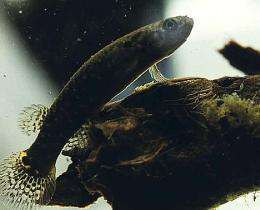Fish species stay alive on land with special skin

(��������Org.com) -- A new study shows how an amphibious fish stays alive for up to two months on land. It's all in the skin.
Mangrove killifish are small fish, only about an inch or two long, that live in temporary pools in the coastal mangrove forests of Central and South America and Florida. During dry seasons when their pools disappear, the fish hole up in leaf litter or hollow logs. As long as they stay moist, they can survive for extended periods out of water by breathing air through their skin. But oxygen isn’t the only thing a fish out of water needs to worry about, according to Professor Patricia Wright, a biologist from the University of Guelph, Ontario, who has studied these fish for years.
“All cells in the body need the right combination of ions and water for an animal to stay alive,” Wright explains. “Normally, the gills are responsible for these processes in fish. We knew that in mangrove killifish the gills are likely useless on land, so how these fish maintain ion balance out of water was a mystery.”
Wright’s latest research, published in the November/December 2010 issue of the journal ��������iological and Biochemical Zoology, shows that the skin of the mangrove killifish picks up the slack for the gills.
Through a series of laboratory experiments, Wright and her team found special cells called ionocytes clustered on the skin of the fish. Ionocytes, normally found on the gills of other fish, are the cells responsible for maintaining the right balance of water and salt in a fish’s cells.
“We found the mangrove killifish have roughly as many ionocytes on their skin as on their gills,” Wright said. Other fish species have skin ionocytes in larval stages of development, but usually these cells disappear in the skin as the fish develops.
To show that these skin ionocytes were doing the job, the researchers took some mangrove killifish out of water for a period of 9 days. During that time, the fish were left on a surface moist with water containing a radioactive isotope. The researchers found that the isotope eventually turned up in the fish’s body.
“It’s very clear they’re exchanging ions through the skin,” Wright said.
The skin of the mangrove killifish is also equipped to help the fish deal with varying salinity, the research found. When out-of-water fish were placed on a surface moist with salt water, the skin ionocytes got bigger, indicating that they’re working overtime to keep the right salt balance. When those fish were placed back in water, the skin ionocytes returned to normal size.
It’s adaptations like this, Wright says, that make this fish special—even among amphibious fish. Lungfish, for example, need to alter their physiological state to live out of water. But with its special skin, mangrove killifish can maintain all of their normal physiological processes at nearly the same level as being in water—and they can do it for over 60 days.
“They really are very interesting little animals,” Wright said.
More information: Danielle M. LeBlanc, et al. "A Fish Out of Water: Gill and Skin Remodeling Promotes Osmo- and Ionoregulation in the Mangrove Killifish Kryptolebias marmoratus." ��������iological and Biochemical Zoology 83:6.
Provided by University of Chicago


















